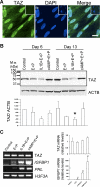Human transcriptional coactivator with PDZ-binding motif (TAZ) is downregulated during decidualization
- PMID: 20164440
- PMCID: PMC2874497
- DOI: 10.1095/biolreprod.109.081844
Human transcriptional coactivator with PDZ-binding motif (TAZ) is downregulated during decidualization
Abstract
Transcriptional coactivator with PDZ-binding motif (TAZ) is known to bind to a variety of transcription factors to control cell differentiation and organ development. However, its role in uterine physiology has not yet been described. To study its regulation during the unique process of differentiation of fibroblasts into decidual cells (decidualization), we utilized the human uterine fibroblast (HuF) in vitro cell model. Immunocytochemistry data demonstrated that the majority of the TAZ protein is localized in the nucleus. Treatment of HuF cells with the embryonic stimulus cytokine interleukin 1 beta in the presence of steroid hormones (estradiol-17 beta and medroxyprogesterone acetate) for 13 days did not cause any apparent TAZ mRNA changes but resulted in a significant TAZ protein decline (approximately 62%) in total cell lysates. Analysis of cytosolic and nuclear extracts revealed that the decline of total TAZ was caused primarily by a drop of TAZ protein levels in the nucleus. TAZ was localized on the peroxisome proliferator-activated receptor response element site (located at position -1200 bp relative to the transcription start site) of the genomic region of decidualization marker insulin-like growth factor-binding protein 1 (IGFBP1) in HuF cells as detected by chromatin immunoprecipitation. TAZ is also present in human endometrium tissue as confirmed by immunohistochemistry. During the secretory phase of the menstrual cycle, specific TAZ staining particularly diminishes in the stroma, suggesting its participation during the decidualization process, as well as implantation. During early baboon pregnancy, TAZ protein expression remains minimal in the endometrium close to the implantation site. In summary, the presented evidence shows for the first time to date TAZ protein in the human uterine tract, its downregulation during in vitro decidualization, and its localization on the IGFBP1 promoter region, all of which indicate its presence in the uterine differentiation program during pregnancy.
Figures




Similar articles
-
Growth regulation by estrogen in breast cancer 1 (GREB1) is a novel progesterone-responsive gene required for human endometrial stromal decidualization.Mol Hum Reprod. 2017 Sep 1;23(9):646-653. doi: 10.1093/molehr/gax045. Mol Hum Reprod. 2017. PMID: 28911214 Free PMC article.
-
Manipulating actin dynamics affects human in vitro decidualization.Biol Reprod. 2009 Jul;81(1):222-30. doi: 10.1095/biolreprod.108.074666. Epub 2009 Apr 1. Biol Reprod. 2009. PMID: 19339710 Free PMC article.
-
Parathyroid hormone-like hormone (PTHLH) represses decidualization of human uterine fibroblast cells by an autocrine/paracrine mechanism.J Clin Endocrinol Metab. 2011 Feb;96(2):509-14. doi: 10.1210/jc.2010-1790. Epub 2010 Nov 10. J Clin Endocrinol Metab. 2011. PMID: 21068146 Free PMC article.
-
Uterine receptivity and implantation: the regulation and action of insulin-like growth factor binding protein-1 (IGFBP-1), HOXA10 and forkhead transcription factor-1 (FOXO-1) in the baboon endometrium.Reprod Biol Endocrinol. 2004 Jun 16;2:34. doi: 10.1186/1477-7827-2-34. Reprod Biol Endocrinol. 2004. PMID: 15200677 Free PMC article. Review.
-
Implantation in the baboon: endometrial responses.Semin Reprod Endocrinol. 1999;17(3):257-65. doi: 10.1055/s-2007-1016233. Semin Reprod Endocrinol. 1999. PMID: 10797944 Review.
Cited by
-
Cofilin and slingshot localization in the epithelium of uterine endometrium changes during the menstrual cycle and in endometriosis.Reprod Sci. 2011 Oct;18(10):1014-24. doi: 10.1177/1933719111401663. Epub 2011 Jun 21. Reprod Sci. 2011. PMID: 21693774 Free PMC article.
-
Hippo signaling in mammalian reproduction.Reproduction. 2025 May 30;169(6):e250016. doi: 10.1530/REP-25-0016. Print 2025 Jun 1. Reproduction. 2025. PMID: 40378301 Free PMC article. Review.
-
Differential MicroRNA Expression Involved in Endometrial Receptivity of Goats.Biomolecules. 2021 Mar 22;11(3):472. doi: 10.3390/biom11030472. Biomolecules. 2021. PMID: 33810054 Free PMC article.
-
Yes Associated Transcriptional Regulator 1 (YAP1) and WW Domain Containing Transcription Regulator (WWTR1) are required for murine pregnancy initiation.bioRxiv [Preprint]. 2024 May 21:2024.05.09.592984. doi: 10.1101/2024.05.09.592984. bioRxiv. 2024. PMID: 38766130 Free PMC article. Preprint.
-
STK3/4 Expression Is Regulated in Uterine Endometrial Cells during the Estrous Cycle.Cells. 2019 Dec 15;8(12):1643. doi: 10.3390/cells8121643. Cells. 2019. PMID: 31847471 Free PMC article.
References
-
- Perissi V, Rosenfeld MG.Controlling nuclear receptors: the circular logic of cofactor cycles. Nat Rev Mol Cell Biol 2005; 6: 542–554. - PubMed
-
- Hong JH, Hwang ES, McManus MT, Amsterdam A, Tian Y, Kalmukova R, Mueller E, Benjamin T, Spiegelman BM, Sharp PA, Hopkins N, Yaffe MB.TAZ, a transcriptional modulator of mesenchymal stem cell differentiation. Science 2005; 309: 1074–1078. - PubMed
-
- Park KS, Whitsett JA, Di Palma T, Hong JH, Yaffe MB, Zannini M.TAZ interacts with TTF-1 and regulates expression of surfactant protein-C. J Biol Chem 2004; 279: 17384–17390. - PubMed
Publication types
MeSH terms
Substances
Grants and funding
LinkOut - more resources
Full Text Sources
Research Materials

